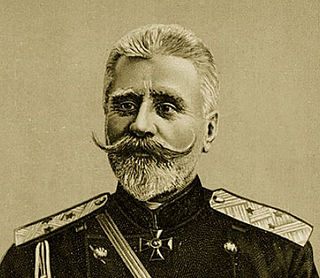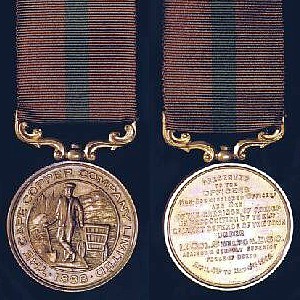The Defenders of Port Arthur Medal was an unofficial commemorative medal of France, issued privately to reward Russian officers and soldiers who had fought in the defence of Port Arthur.
The Defenders of Port Arthur Medal was an unofficial commemorative medal of France, issued privately to reward Russian officers and soldiers who had fought in the defence of Port Arthur.
Funds were raised for it by Henri Simon, publisher of the L'Écho de Paris newspaper, who raised around 100,000 Francs. This paid for gifts to reward Anatoly Stessel, the Russian commander at Port Arthur, and for the medals' manufacture and delivery. However, whilst the charity was organising for the medals to be collected, delivered and stamped in Russia, Stessel was put on trial for his surrender of Port Arthur. This substantially affected the course of the medal's history - it was not a Russian state award to the defenders of Port Arthur, although a silver issue of a later Russo-Japanese War Medal was struck for them. Later, on the tenth anniversary of the siege, the Port Arthur Cross was established.
Gilded silver medals were issued to officers, silver to non commissioned officers and bronze for ordinary sailors, soldiers, nurses, port workers and others involved in the defence. Direct heirs of those killed in the siege could also apply for a medal.
After Stessel's trial, the medals were kept in storage for a long while at Russia's Naval Ministry. It was eventually decided to distribute them, on the condition that a medal holder could only wear it if he or she personally paid for Stessel's name to be removed from it. Most recipients declined to do this and so from 1 December 1910 they were issued but with no right to wear them.

The Russo-Japanese War was fought between the Empire of Japan and the Russian Empire during 1904 and 1905 over rival imperial ambitions in Manchuria and the Korean Empire. The major theatres of military operations were located in Liaodong Peninsula and Mukden in Southern Manchuria, and the Yellow Sea and the Sea of Japan. Russia sought a warm-water port on the Pacific Ocean both for its navy and for maritime trade. Vladivostok remained ice-free and operational only during the summer; Port Arthur, a naval base in Liaodong Province leased to Russia by the Qing dynasty of China from 1897, was operational year round. Russia had pursued an expansionist policy east of the Urals, in Siberia and the Far East, since the reign of Ivan the Terrible in the 16th century. Since the end of the First Sino-Japanese War in 1895, Japan had feared Russian encroachment would interfere with its plans to establish a sphere of influence in Korea and Manchuria.
To be mentioned in dispatches describes a member of the armed forces whose name appears in an official report written by a superior officer and sent to the high command, in which their gallant or meritorious action in the face of the enemy is described.

The Good Conduct Medal is one of the oldest military awards of the United States Armed Forces. The U.S. Navy's variant of the Good Conduct Medal was established in 1869, the Marine Corps version in 1896, the Coast Guard version in 1923, the Army version in 1941, and the Air Force version in 1963; the Air Force Good Conduct Medal was temporarily discontinued from February 2006 to February 2009, followed by its subsequent reinstatement.

The siege of Port Arthur was the longest and most violent land battle of the Russo-Japanese War.

The peaked cap, peaked hat, service cap, barracks cover or combination cap is a form of headgear worn by the armed forces of many nations, as well as many uniformed civilian organisations such as law enforcement agencies and fire departments. It derives its name from its short visor, or peak, which was historically made of polished leather but increasingly is made of a cheaper synthetic substitute.

Order of the Medjidie is a military and civilian order of the Ottoman Empire. The Order was instituted in 1851 by Sultan Abdulmejid I.

The siege of Tsingtao was the attack on the German port of Tsingtao in China during World War I by Japan and the United Kingdom. The siege was waged against Imperial Germany between 27 August and 7 November 1914. The siege was the first encounter between Japanese and German forces, the first Anglo-Japanese operation of the war, and the only major land battle in the Asian and Pacific theatre during World War I.

The siege of Kars was the last major operation of the Crimean War. In June 1855, attempting to alleviate pressure on the defence of Sevastopol, Emperor Alexander II ordered General Nikolay Muravyov to lead his troops against areas of Ottoman interest in Asia Minor. Uniting disparate contingents under his command into a strong corps of 25,725 soldiers, 96 light guns, Muravyov decided to attack Kars, the most important fortress of Eastern Anatolia.

Anatoly Mikhaylovich Stessel was a Russian baron of German descent, military leader, and general.
The siege of Reading was an eleven-day blockade of Reading, Berkshire, during the First English Civil War. Reading had been garrisoned by the Royalists in November 1642, and held 3,300 soldiers under the command of Sir Arthur Aston. On 14 April 1643, Robert Devereux, 3rd Earl of Essex brought a Parliamentarian army of 19,000 men to lay siege to the town, and began bombarding the town two days later.

The Victoria Cross (VC) is the highest and most prestigious award of the British honours system. It is awarded for valour "in the presence of the enemy" to members of the British Armed Forces and may be awarded posthumously. It was previously awarded by countries of the Commonwealth of Nations, most of which have established their own honours systems and no longer recommend British honours. It may be awarded to a person of any military rank in any service and to civilians under military command. No civilian has received the award since 1879. Since the first awards were presented by Queen Victoria in 1857, two-thirds of all awards have been personally presented by the British monarch. The investitures are usually held at Buckingham Palace.

The Medal "For the Defence of Odessa" was a World War II campaign medal of the Soviet Union established on December 22, 1942 by decree of the Presidium of the Supreme Soviet of the USSR to reward the participants of the defence of the port city of Odessa from the Axis armed forces of Romania and Nazi Germany. The medal's statute was amended on July 18, 1980 by decree of the Presidium of the Supreme Soviet of the USSR № 2523-X.

The Medal "For the Defence of Sevastopol" was a World War II campaign medal of the Soviet Union established on December 22, 1942 by decree of the Presidium of the Supreme Soviet of the USSR to reward the participants of the defence of the port city of Sevastopol against the armed forces of Nazi Germany and Romania. The medal's statute was amended on July 18, 1980 by decree of the Presidium of the Supreme Soviet of the USSR № 2523-X.

The Liège Medal was an unofficial World War I campaign medal issued by the Belgian city of Liège to its 1914 defenders against the German invaders. It was first issued in April 1920 during a large ceremony presided by the Duke of Brabant and Lieutenant General the Count Gérard-Mathieu Leman, military commander of the defence of Liège during the battle which raged from the 5th to the 16th of August 1914. The stubborn defence of the city forced the Germans to bring in specialised extra heavy artillery to take on the city fortifications.

Konstantin Nikolaevich Smirnov, was a general in the Imperial Russian Army.

In the Colonies and Boer Republics which became the Union of South Africa in 1910, several unofficial military decorations and medals were instituted and awarded during the nineteenth and early twentieth century. The Cape Copper Company Medal for the Defence of O'okiep is a private campaign medal which was instituted by the Cape Copper Company Limited in 1902. The medal was awarded to members of the O'okiep Garrison who defended the town while it was besieged by Boer Commandos from 4 April to 4 May 1902, near the end of the Second Boer War.
The siege of Lyme Regis was an eight-week blockade during the First English Civil War. The port of Lyme Regis, in Dorset, was considered to be of strategic importance because of its position along the main shipping route between Bristol and the English Channel. Thomas Ceeley and Robert Blake commanded the town's Parliamentarian defences during the siege, which was laid by Prince Maurice between 20 April and 16 June 1644.

The Royal Guernsey Militia has a history dating back 800 years. Always loyal to the British Crown, the men were unpaid volunteers whose wish was to defend the Island of Guernsey from foreign invaders.

The Port Arthur Cross or Cross for the Defence of Port Arthur was a medal awarded by the Russian Empire. It was instituted on 14 January 1914 to mark the tenth anniversary of the siege of Port Arthur. It was awarded in silver to officers and in bronze to the other ranks.